 Seashell examples - Photos and descriptions
Seashell examples - Photos and descriptions





![]() Different Types and Names of Seashells - Identification With Pictures:
Different Types and Names of Seashells - Identification With Pictures:
Below are many different types of seashell examples and descriptions of each of them. These are also the same types of shells you
would find on other beaches or in other states, but the colors and textures of different shells can always vary. Shell colors are also affected by
age, because the shells bleach more and more white the longer they are in the sun and tides.
Oyster shell photo
These shells can have random shapes and sizes, with smooth surface or raised shell edges, and can be "rigid texture" on top of shell. Although most of those found are just shades of grey or black color, if you spend time searching you can find some larger and unbroken, with different textures raised and running across the top of the shells, and you can find colors that are jet black, pure white, or even purple and orange striped combinations as shown. Some even have lots of variation with shell texture across the top or ridges around the shell edges.
See more oyster shell details
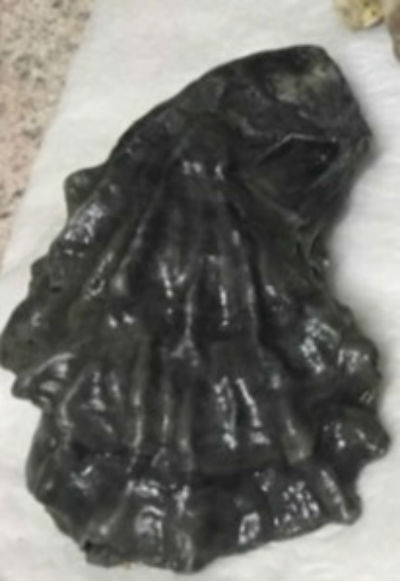
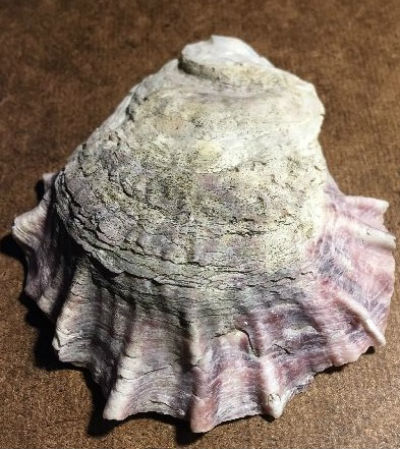
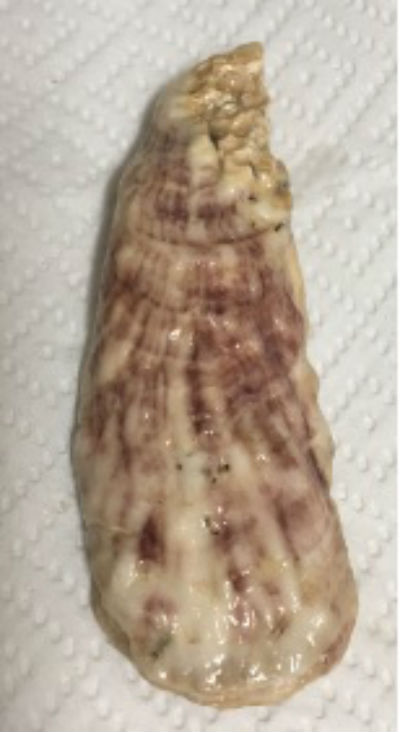
Olive seashell photo
These shells are "long and narrow" (oblong or cyclinder shaped shell) and are spiraled on end. They can be a "smooth shell surface" like glass or rough from all the tumbling in the water. The lettered olive shell can have various colors but its also very common to be found completely white. These shells are "pointed on end" and often has hole in tip from banging against rocks or other shells in the water. Long narrow opening running the length of the shell.
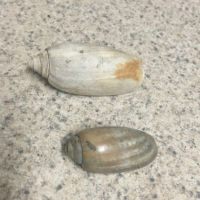
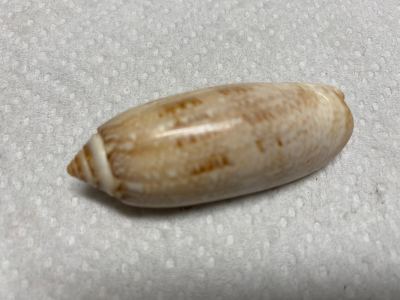

Murex seashell photo
These shells are some of the most unique designs of any shell I have seen, and have a very "spiky surface" all across the back and sides of it. Shells can have many "pointed" edges sticking out in many places even on the shell opening. These shells can be some of the most unusual and different seashell types, and can also have a pink or orange color along the hole opening. No 2 shells look the same as they have "horns", "spikes", or "teeth" edges sticking out in random directions that run all along the shell lip opening and down the back side of the shell as shown in the photos.
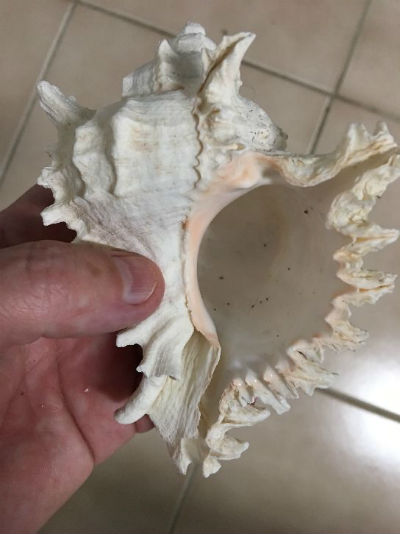
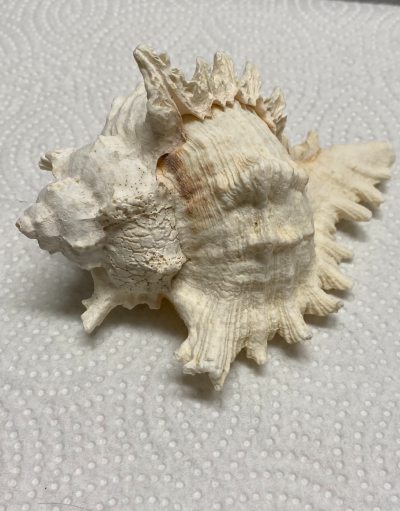
Whelk seashell photo
The "whelk seashell" can include wide ranging colors and "stripes along the shell body". The lightning whelk is easily identifiable because opening is on left when you hold it up facing you. These whelk shells have long tails and long spiraled ends. Like all shells they can be bleached from sun or worn from tumbling in the surf. The knobbed whelk shell is broader and has large spiral front face as shown below. The pear whelk shell is the smallest, looks like a fig shape, and is smoother. The channeled whelk has end extended outward from spiral, as if it was pulled out. Sand and churning in tides can often smooth out shells so some of these textures can vary.
See more whelk shell details
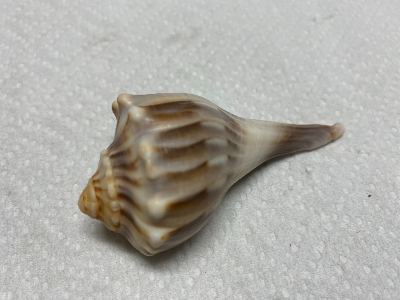
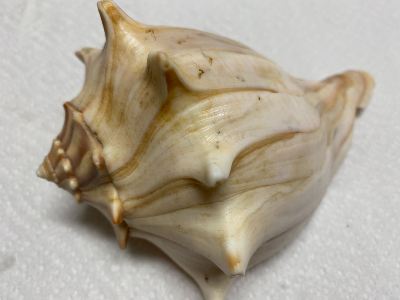
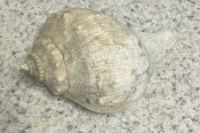
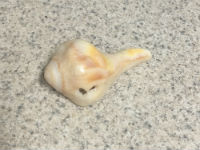
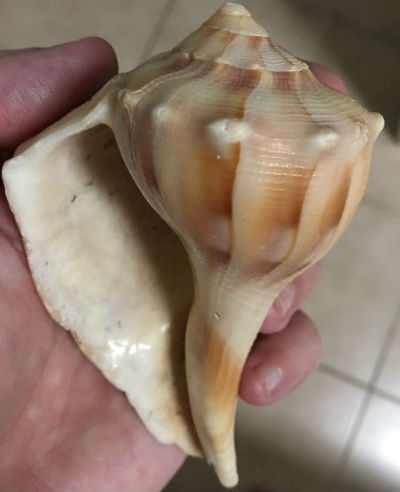
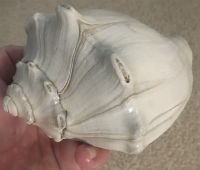
Coral or worm rock photo
Although not a seashell, coral can be found in the same location and can be as cool as any seashell. These here are common where I hike, and you can find pieces in many sizes including larger chunks. From research I think these are a type of worm rock that is on top of the coral.
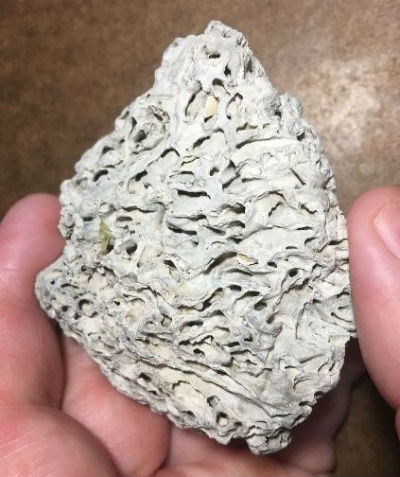
Moon snail shell photo
These snail shells are a round and "spiraled shell" and can be found in dark or lighter colors. These seashells have a "curled up" look to them, and the moon snail shell is also called the shark eye shell. These can be large baseball sized round shell or smaller shell about the size of a nickel. Although I tend to find these broken alot, the good thing is often that top circular spiral top piece remains, and if setting on your desk that looks as good as having the entire shell. You may think its some type of "flat" or "round seashell" but thats because the bottom section is often missing. In the photo below the large circular one on the left has the entire underside of the shell missing, but the top section is the key part to have.


Cockle seashell photo
These cockle shells are larger (I have found several the size of my hand) and ridged across the top of the shell. "Vertical ridges" or "lines running down the shell" are often colored as there are different types of cockle shells. These are often broke as larger shells this can easily hit something wrong and crack.
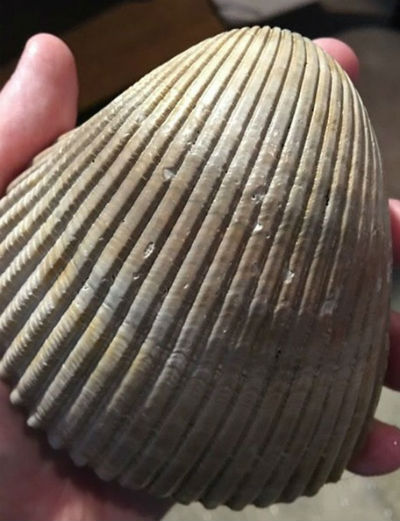
Ark seashell photo
Ark shells come in many different types, and often have a curled nose or twist at end. Vertical ridges or lines run down the shell similiar to a cockle shell except smaller. Often different shades of brown, black, blue, and many other color combinations. Some are also a far "thicker seashell" while others can be more of a "thin fragile shell".
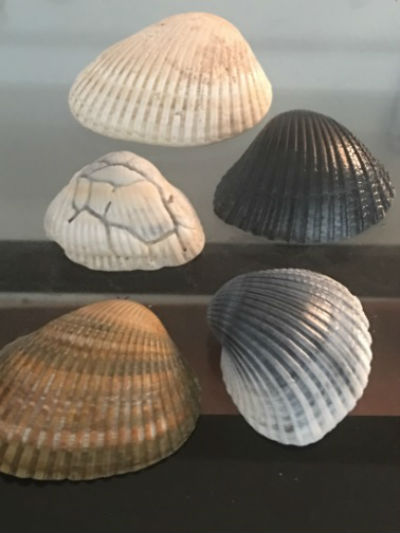
Conch seashell photo
Probably the most popular seashell and the one you always see them selling to tourists is the conch shell. Often known to have pink or red inside the shell, and has a lip that extends way out and flattens. Many people confuse conch seashell vs whelk seashell because they can both be huge, large shells, but the conch shell has the lip or opening that extends out flatter and also has the sharp point and large horns or "teeth" on the back of the shell.
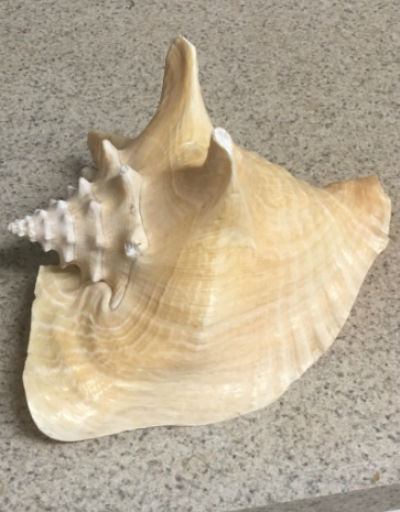
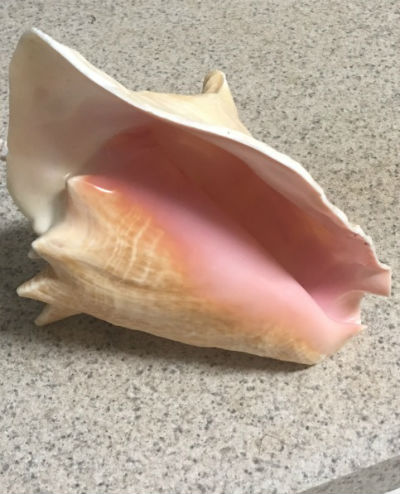
Freshwater snail shell photo
The freshwater snail shells are often thinner and lighter then the snail shells found on ocean beaches and do have a different look and feel to them. Like most snails these shells are "spiral, round shells" and look "curled" but are found in freshwater locations, not saltwater beaches.
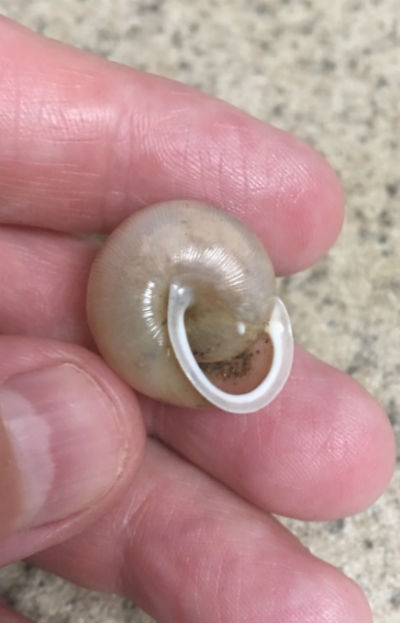
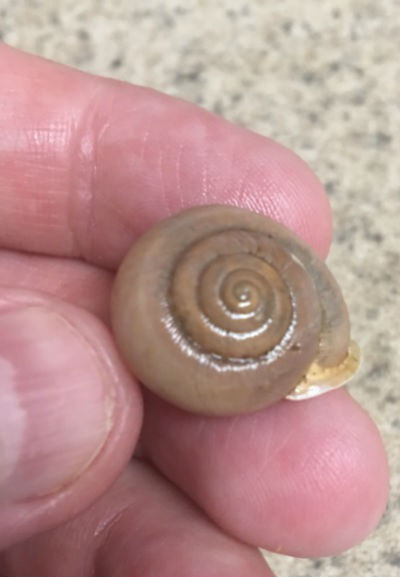
Clam shell photo
There are many different types of clams, and the ones you see most often are called quahog clam or hard clam shells. These are "smooth clam shells" but often have slight "horizontal ridges" if you run your finger over them. These are often white, brown, tan, black, grey or blue colors so they do have variations. The shells are thick and hard. They can have horizontal color patterns or rows on the shells. These are fairly large and thick, 3 to 7 inches in size. Quahog shells are the best ones to put mineral oil on as the colors really come out sharply. The tan striped one on the left was completely white before I put the mineral oil on it, surprising just how much it changed. Black clam shells will become a very dark shiny black when you do this with those shells. Just a very light amount for a few seconds is enough.
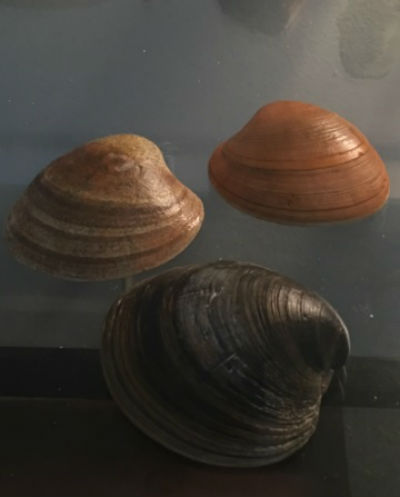
I originally thought these round smooth shells found on ocean beach were a similiar clam, but now I'm not sure which types these are as these are very smooth shells. The shells feel glass like and are smaller around 1 inch in size.
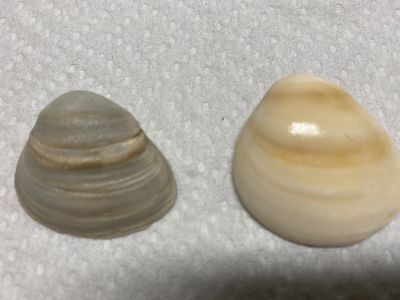
Jingle seashell photo
These seashells are very light weight and "flimsy shell" found on ocean beaches, and look like a "polished seashell". These seashells are almost translucent where if you hold up to the light its somewhat see through shell. These shells can crack or split easily, so rubbing some mineral oil lightly on shells like this can help preserve the shell and also help it keep that shiny look.
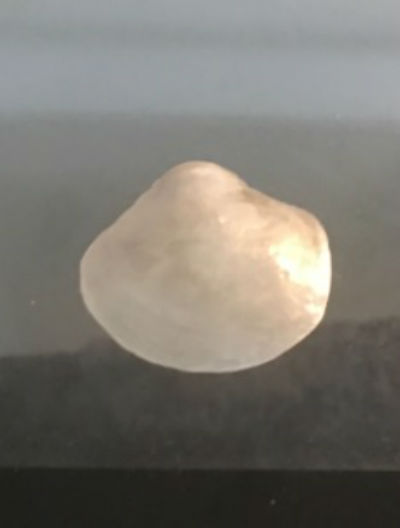
Coquina seashell photo
These seashells are very small (size of a dime) and oblong shaped, but if you look closely in seashell piles on the beach you sometimes can find these in bunches. Its just that they are so small most dont pick them up. These are smooth like glass and can come in a wide range of different types of colors as you may find them purple or tan striped, white, or even shaded black colors. The shells may also be more flat and others more rounded as shown.
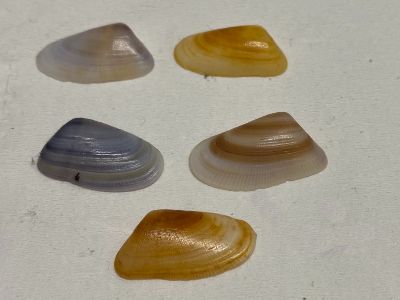
Coral photo
Not a seashell but a very cool item, these can range in colors and is a hard material once dry. Has holes where ocean water previously filtered through. Alot of things can be called part of coral, as barnacles, worm rock, coral itself, all attach and grow on other things and all can wash ashore on the beach.
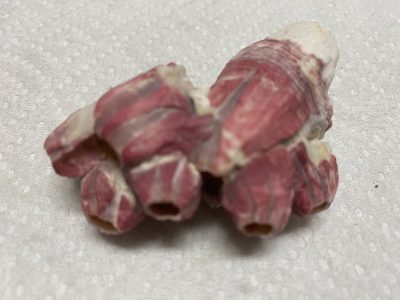
Crab claw photo
You often can find different types of crab claws on the beach ranging from 1 inch to 3 inches. These can range in all different types and colors depending upon what type of crab it was from but make sure there is no meat in it! Usually by the time they are on the beach it was cleaned out long ago. This maroon red colored claw I tried to identify but I'm not sure what type of crab it is from.
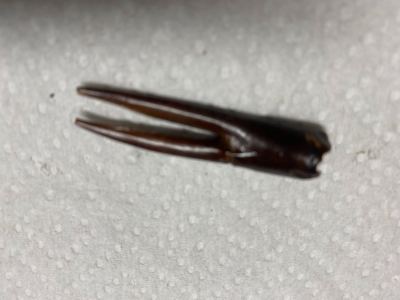
Not sure what type of seashell this is?
I originally thought it was a crabshell but now I think thats wrong and its some type of small seashell. Very light, thin, and "flimsy shell", but has a very nice color to it. This shell is between 1 to 2 inches across. If you recognize the type of shell this is, post below and let me know. This is the only one like this I have ever seen on the beach.
Update: This is a crab shell. Thanks for helping to identify this.
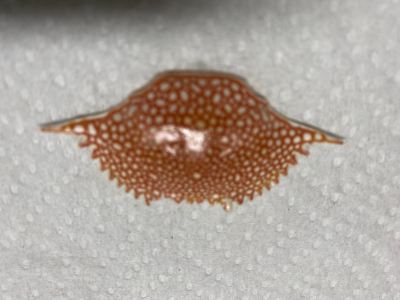
Duck clam seashell photo
The duck clam is a very thin and light shell that can crack easily. "Round with horizontal ridges" running across this shell. Normally white or grey or light colored, slightly "translucent shell" if you hold it up to light. Adding a little clear mineral oil rubbed on the shell can help protect it from cracking and keep the shine.
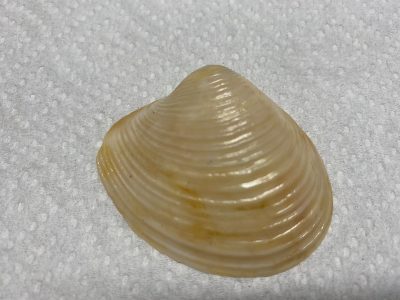
Fish grinding teeth / plate and fossilized sharks teeth
These are black fossilized sharks teeth on the bottom which I found in the sand. If the sharks teeth are black, red or brown, then they are fossilized teeth but some people actually find the white teeth which are more recently lost. Usually they are always black so finding off colored shark teeth like red or brown are more rare. Several different types of sharks teeth are shown here, sand tiger shark and lemon shark are 2 of the types in this photo. One is a more "rare" red colored shark tooth. If you are wondering why the sharks teeth are black, its because when they fossilize all the calcium gets replaced with minerals that its buried in and its usually a dark color but in rare scenarios it can be other colors. Note that this takes roughly 10,000 years, so when you find one of these its at least that old!
These 2 "clustered teeth" in a group at the top of photo are the grinding plates from a drum fish which these are located in back of throat and used for crushing crabs, oysters, barnacles and other types of food that these fish feed on. These groups of round teeth are larger on bigger drum of course, these 2 shown are the width of a quarter across.
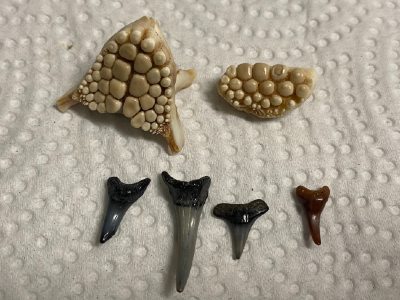
Jackknife clam seashell photo
The jackknife clam shell is a "long skinny shell", or as I would describe a "fingernail type seashell", long and rectangular that is very smooth surface with varying colors. This is sometimes called a razor clam shell. This one is 5 inches long.
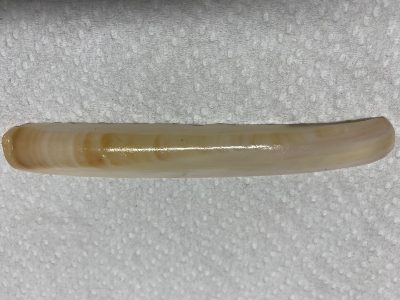
Pen shell photo
These are very common and all over the beach in my area. This one is about 7 inches long and originally I thought these were just vegetation washed up because they are so common and very light and breakable shell. It will crack or split easily if you arent carefull, but its actually a pen seashell. Sharp ridges stick out near the edges and the shell is always pointed on one end. Like other shells I added some clear mineral oil rubbed on it to help preserve it.
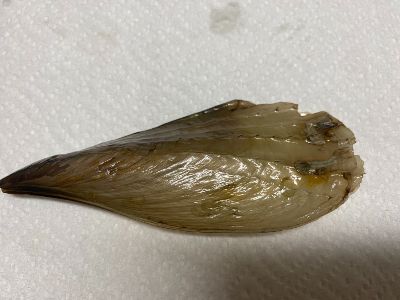
Atlantic oyster drill snail seashell photo
Small, thick seashell with extended "spiral point" (normally not over 1 inch long). "Textured shell" that can have varying colors and shell ridges.
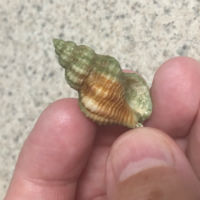
Circular beach rock?
Not a seashell but since I never find rocks washed up on the beach, I assume this is something different because its so flat, but I'm wondering what it is.
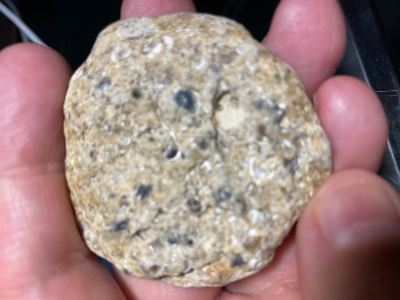
Nutmeg seashell photo
Extended spiral point but also broad seashell for its size. Textured outer shell but smaller in length, roughly max size of 2 to 3 inches
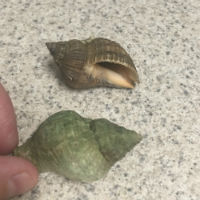
Calico scallop seashell photo
These are some of the most colorful shells you can find. They are small (size of dime or quarter usually) but contain colorful patterns and variation of purple or red among others. Usually has the square hinge or square corners at the top of it but often thats broken or worn off. Has vertical lines and ridges running down the shell.
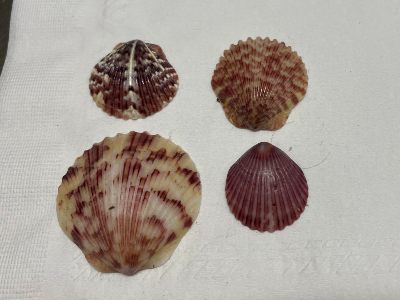
Slipper seashell photo
These round and perfectly smooth glass like shells are slipper shells. These are small and "varying colored shell" (about 1 to 1.5 inches on these) including black, white, tan, brown, etc.
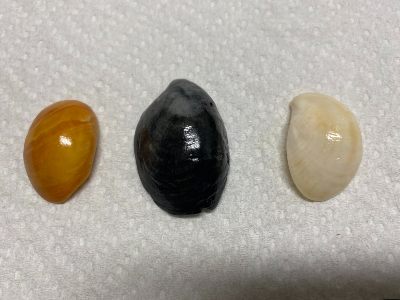
Angel wing seashell photo
These are called "angel wing shells" due to the off center wing like shape of the shell. Very common to find these broken as the shell isnt very thick and easily cracks and breaks when tumbling in tides and hitting rocks or other shells. This one is a good 4 to 5 inches across. I often find these in my area, but they are almost always partial, broken shells.
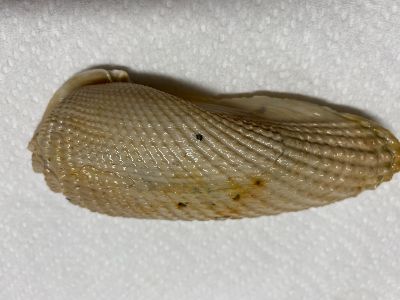
Auger shell photo
These are skinny shells, long twisted narrow shells called "auger shells". These are easily identified because not many shells look similiar to these, pointed on one end and shell opening on opposite end. Although these are small in this photo its not uncommon to find them several inches long.
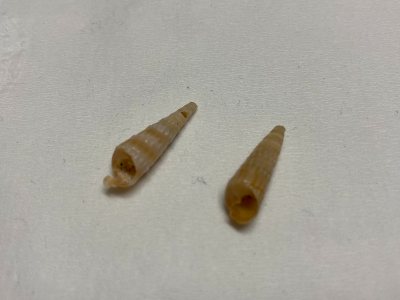
What is it?
I dont know what this is, but its kind of cool. It feels like a very lightweight bone, almost like really solid cardboard with spotted pattern running across it as shown. I was thinking maybe it was some type of bony plate off a turtle shell or a top fin off some type of bony fish, but I cant make sense out of it. If you recognize this black checkered pattern please post it below. It was found on the beach (atlantic ocean) like everything else shown here and this is about 1.5 to 2 inches on the edge.
Update: This has been identified as a section from a sand dollar. Thanks for helping to identify this. A sand dollar is a "flat" or "round" shaped shell like creature often found on beaches because they dry out similiar to a star fish. People often search specifically for these as some beaches have them far more then others. All beaches and ocean areas are definitely not the same for sand dollars or seashells. Where I go these are there but always broken and the textured pattern completely threw me off as I have never seen that here. When I find a whole sand dollar I will add the photo here :-) If you rub in a little mineral oil on it the textured color and pattern comes out even more. You can see in this photo that the inside is almost bone like or cardboard like structure, but its completely solid when you pick it up, and different color or checkered patterns can be on both sides.
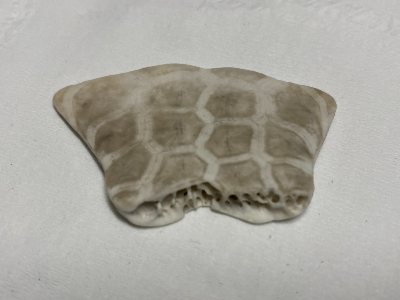
Razor clam shell
This is a long, oval, and oblong shaped shell. There are different types of razor clamshells, ranging from the long skinny jacknife shell shown above vs this elongated oval shell style. It is a smooth surface with brown and tan horizontal colorored layers running across the shell but that can vary of course. This one is about 5 inches long.
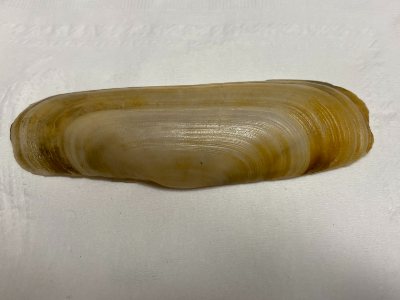
Partial and aged shells
Partial shells with a "weathered" look.
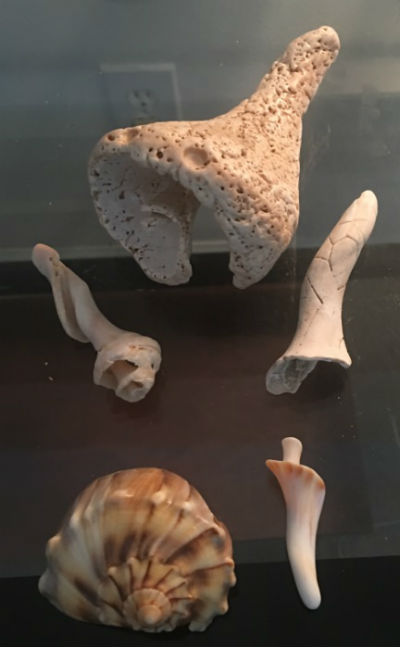
Answer - Anonymous
The spotted orange colored shell with pointed ends is a crab shell. Not sure what type of crab but lookup blue crab and look at the shell on its back, it exactly matches that shape just different color.
Answer - Anonymous
The one that you did not know type of shell it is it is a crab shell all types of crab shells have a different type it is a “purse crab” so yeah
Answer - Anonymous
Hello,thank you for your hard work!!! I am approaching 50, and shells have been THE only part of my life I have loved since day 1 up to now!!! hey, I knew it was a broken sand dollar, the "turtle" piece..just had to find photo...gonna try to attach it :) well I cant attach it. it is purple design thanks a bunch
Answer - Anonymous
Now that you say that, thats exactly what it is! Thanks, I see it now looking at other sand dollar photos. What threw me off was the sides of that piece are not broken, its only the bottom section, but I see now thats because sand dollars have those slits throughout so there wont be a break there if its a piece in the middle of it. Glad to know what that is :-)
Yeah shell hunting is addictive once you start doing it a few times, plus its good exercise just getting out there and searching. I do the same thing now with rock hounding where I do hiking areas and along creeks and searching for different types of colored rocks or arrowheads or that type of stuff.
Answer - Anonymous
Yeah thats definitely a crab shell on the orange spotted unknown shell above. Thanks, it does look identical to the top of a crab when I search through photos of them so thats clearly what it is.
Answer - Anonymous
good info, thanks
Answer - Anonymous
One day out walking the beach I picked up one neat looking shell and was excited to find one like that because I never see those (it had the long opening and pointed like your pictures above, not sure if it was the same type or not). When I picked it up and turned it over the smell was unbearable lol, I didnt want to touch it again, something clearly was dead inside it.
Answer - Anonymous
I've picked up shells that stink like that also, it takes your breath away. If its really a shell you like then what I would do is grab it on the way home and put it in plastic bag, then when you get home set it on ant hill outside, the ants will clean out every little thing over the next week. Otherwise you can set it somewhere pointed up also as the flies will find it quickly and they will clear it out. Then you can bring it in after a few weeks and wash it with dish soap and it will be fine :)
Be aware you can never take a shell with something alive in it, most states have laws against this. Often looking in the shell you cant see it either as they pull back way far inside, especially if you pick the shell up in a wet area (not dried out in sun high up on beach etc) chances are something may be in it. The easy way I found to check it is set it opening pointed up on the beach and stand a ways away from it. If there is something in it, it will flip the shell over once it realizes its alone and doesnt like the light shining in. Once a few minutes pass and its still pointed up, most likely its empty. I've used that method many times, and I was surprised sometimes the shell flipped back over because I couldnt see anything in it when I looked. :^)
Answer - Anonymous
Its pretty how some beaches you find completely different types and colors. Like Sanibel Island in Florida or shell island in Panama City Beach Florida, they have so many shells piled everywhere and so MANY different colors, it makes you think that all other beaches are worthless for shell hunting (although be aware many also have live stuff in it). Where I do my shell hunting, I find ark shells and pen shells but very rare to find other stuff. Conch shells - never. Oyster shells - never. Yet other places they find these everywhere, so different areas matter alot.
Answer - Anonymous
Its pretty crazy how some beaches you find completely different shell types and colors.
Like Sanibel Island in Florida or shell island in Panama City Beach Florida, they have so many shells piled everywhere and so MANY different colors, it makes you think that all other beaches are worthless for shell hunting (although be aware many there also have live stuff in it). Where I do my shell hunting, I find ark shells and pen shells but very rare to find other stuff. Conch shells - never. Oyster shells - never. Yet other places they find these everywhere, so different areas matter alot.
Add your reply below ...